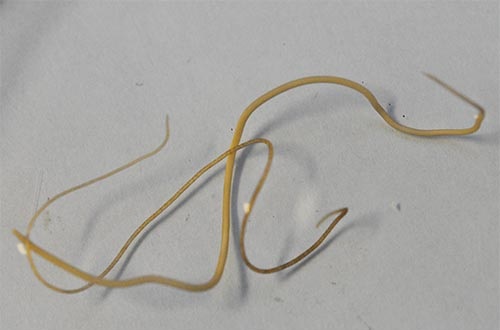Horsehair Worms
ENTFACT-613: Horsehair Worms | Download PDF
by Lee Townsend, Extension Entomologist
University of Kentucky College of Agriculture
Horsehair worms, also known as Gordian worms, belong to the group Nematomorpha. They are similar to nematodes but much longer (4 inches or longer) and very thin (1/80 to 1/10 inch diameter). They are found in water or wet areas, such as in or alongside streams or puddles but they can occur in cisterns, livestock watering troughs or most open outdoor container with water. These harmless, curious creatures writhe slowly, contorting their hair-like bodies into intricate knots.

Horsehair worms develop as parasites in the bodies of grasshoppers, crickets, cockroaches, and some beetles. When mature, they leave the host to lay eggs. They are not parasites of humans, livestock, or pets and pose no public health threat.
Life Cycle
Adults mate in water and females lay long gelatinous strings of eggs. Depending on water temperature, the eggs hatch in 2 weeks to 3 months. The life of the microscopic larvae is not completely understood. Within 24 hours of hatching, the worm is thought to form a protective covering or cyst. If the cyst is eaten by a suitable insect, the protective covering dissolves and the released larva bores through the gut wall and into the body cavity of the host. There, it digests and absorbs the surrounding tissue. When mature, it leaves the host insect to start the process again.
Control
These long, slender creatures are harmless so there is no need for control. Their presence indicates that a cricket or some other host insects got in the container and died, releasing the worm. Check for cracks or openings that can be screened or sealed. The horsehair worms are not a problem but contamination from other sources can be.
Legends
Tangled masses of these worms can be found In the spring. This has led to a variety of stories about their origin. The name “horsehair worm” refers to the old belief that they came from horse hairs that fell into water and came to life. Cabbagehair worm is used in some localities because they can be found in the water droplets that collect in cabbage leaves. Since they are usually contorted into “knots”, the name Gordian worm was used by some. According to Greek legend, King Gordius of Phrygia tied a complicated knot. The first person to untie it would be the future ruler of Asia. Alexander the Great was not able to untie the knot so he cut through it with his sword. Although biologists have partially untied the mystery of these knotty worms, certain aspects of their biology are still coiled up tightly.
Issued: 2/93
Revised: 4/16
CAUTION! Pesticide recommendations in this publication are registered for use in Kentucky, USA ONLY! The use of some products may not be legal in your state or country. Please check with your local county agent or regulatory official before using any pesticide mentioned in this publication.
Of course, ALWAYS READ AND FOLLOW LABEL DIRECTIONS FOR SAFE USE OF ANY PESTICIDE!
Images: University of Kentucky.
